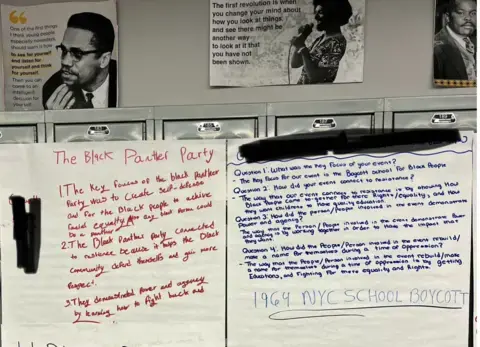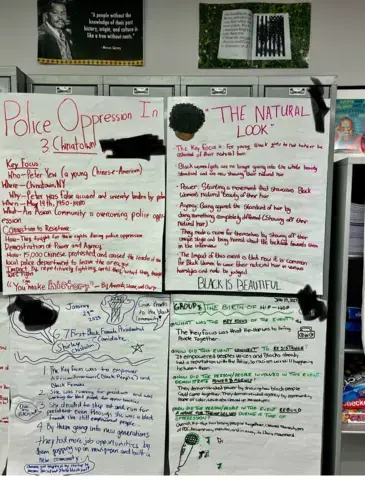This unit was created by the Ascend Social Studies team as part of the 2022 cohort of The 1619 Project Education Network. It is designed for facilitation across approximately six 60-minute lessons.
Objectives:
Students will…
- Define the Reconstruction period by describing its key events and themes
- Formulate a working thesis as to whether the project of Reconstruction is complete today
- Closely read the text to identify how Enslaved Black Americans used their power and agency during enslavement
- Identify and describe the impact of Black political and economic leaders during the Reconstruction Period
- Explain how Black Americans and people of color resisted oppression and injustice, rebuilding their identities (socially, culturally, and politically) between the 1950-1980s
- Analyze the impact of mid-century movements led by Black Americans and people of color
- Argue whether the U.S. is currently in a third Reconstruction period
- Identify and evaluate different methods of power-building and resistance according to their contemporary relevance
Unit Overview:
“Reconstruction In Five Acts” extends the work of The 1619 Project by investigating
- The effects of slavery and its afterlives in the United States
- The multiple legacies of Black resistance, agency, and power-building during Reconstruction and beyond.
This unit is not an exhaustive account of Reconstruction. Instead, it moves thematically by highlighting key themes from the first Reconstruction period, the Civil Rights era (sometimes known as the U.S.’s “Second Reconstruction”), and the present day, encouraging students to consider whether the country is undergoing a third Reconstruction period.*
Two essential questions drive the unit:
- How did Black people and people of color wield power and resistance, rebuild their identity, and sustain agency throughout history?
- Is America currently undergoing a third Reconstruction? Why or why not?
Throughout the unit, students engage with these questions by analyzing primary and secondary sources, including 1619 Project content, and holding various forms of collaborative debate and discussion.
Unit Structure:
The first four lessons support the first essential question.
The first lesson opens with an introduction to the Reconstruction period and a preview of the unit content. Lessons 2-4 highlight Black resistance, agency, and power-building during the Civil War itself, Reconstruction, and the Civil Rights era respectively. These lessons examine the “general strike” of enslaved people during the Civil War that crippled the South and led to the Union victory, the flourishing of Black Southern economic and political power following the war, and the advent of radical BIPOC movements in the mid-20th century.
In the fifth and final lesson, students consider the second essential question, examine present conditions, and evaluate ways to carry on the tradition of Black resistance.*Note: The ideas of the “afterlives of slavery” and the “general strike” of the enslaved come from Saidiya Hartman and W.E.B. DuBois, respectively.
Performance Task(s):
Teachers may select either one or both options which allow students to demonstrate mastery of the content:
- Socratic Seminar
- Essay
Six 60-minute lessons for teachers, including pacing, texts, student exemplars for student discussions and compositions and teacher-created packets and presentations. Download below and scroll down to review key resources included in the unit plan.
Unit Resources
| Resources from The 1619 Project Magazine | “The Idea of America” by Nikole Hannah-Jones “The Wealth Gap” by Trymaine Lee |
| Additional 1619 Texts | The 1619 Project: A New Origin Story The 1619 Project Supplementary Broadsheet |
| Additional Resources | Reconstruction Timeline on Padlet (Accessible digitally or printed) Civil Rights and the 1950s: Crash Course US History #39 (11:57) The Gilded Age | The Black Elite | HBO Clip Teacher-created packets, rubrics and presentations linked throughout the unit |
Common Core Standards:
Cite specific textual evidence to support analysis of primary and secondary sources.
Determine the central ideas or information of a primary or secondary source; provide an accurate summary of the source distinct from prior knowledge or opinions.
Identify aspects of a text that reveal an author's point of view or purpose (e.g., loaded language, inclusion or avoidance of particular facts).
Integrate visual information (e.g., in charts, graphs, photographs, videos, or maps) with other information in print and digital texts.
Distinguish among fact, opinion, and reasoned judgment in a text.
Analyze the relationship between a primary and secondary source on the same topic.
Summative Tasks
Students used a teacher-created packet to prepare for a Socratic Seminar. During the activity, students scored a partner's participation. Although there are no samples of essays, students can also or alternatively complete an essay. Rubrics for both options are linked in the pacing guide.
Formative Tasks:
Students completed a Student Response Packet (SRP) for each lesson leading up to the performance task. Review three separate sets of SRPs for each day of instruction.
Lesson 1: Introducing Reconstruction - Yesterday & Today
Lesson 2: Reconstruction & Enslavement
Lesson 3: Reconstruction Figures
Lesson 4: Civil Rights Era
Lesson 5: The Current Reconstruction



